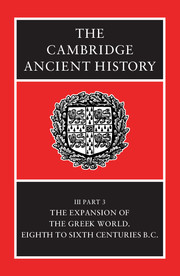Book contents
- Frontmatter
- Contents
- List of maps
- List of text-figures
- Preface
- 36a The Greeks in the Near East
- 36b The Greeks in Egypt
- 36c Cyprus
- 36d The Cypriot syllabary
- 37 The colonial expansion of Greece
- 38 The western Greeks
- 39a The eastern Greeks
- 39b Crete
- 39c Cretan Laws and Society
- 39d Euboea and the Islands
- 40 Illyris, Epirus and Macedonia
- 41 Central Greece and Thessaly
- 42 The Peloponnese
- 43 The growth of the Athenian state
- 44 The Tyranny of Pisistratus
- 45a Economic and social conditions in the Greek world
- 45b The material culture of Archaic Greece
- Chronological Table
- BIBLIOGRAPHY
- Index
- References
40 - Illyris, Epirus and Macedonia
Published online by Cambridge University Press: 28 March 2008
- Frontmatter
- Contents
- List of maps
- List of text-figures
- Preface
- 36a The Greeks in the Near East
- 36b The Greeks in Egypt
- 36c Cyprus
- 36d The Cypriot syllabary
- 37 The colonial expansion of Greece
- 38 The western Greeks
- 39a The eastern Greeks
- 39b Crete
- 39c Cretan Laws and Society
- 39d Euboea and the Islands
- 40 Illyris, Epirus and Macedonia
- 41 Central Greece and Thessaly
- 42 The Peloponnese
- 43 The growth of the Athenian state
- 44 The Tyranny of Pisistratus
- 45a Economic and social conditions in the Greek world
- 45b The material culture of Archaic Greece
- Chronological Table
- BIBLIOGRAPHY
- Index
- References
Summary
Illyrian and Epirotic tribes in Illyris and west Macedonia
‘Illyris’, a geographical term which the Greeks applied to a territory neighbouring their own, covers more or less the area of northern and central Albania down to the mouth of the Aous. A description of the country has been given in CAH III.1, 619ff and 623.
Within Illyris the people to the north of the Shkumbi valley in Illyria were remarkably conservative in their practices during the period, c. 750–530 B.C., and indeed until the beginning of the Hellenistic period. In the Zadrime plain and in the Mati valley tumulus-burial was practised as in the past, and without diminution until late in the fourth century; thereafter a few tumuli only were added to the existing hundreds. Similarly the local styles of pottery persisted and the influence of Greek pottery was very slight. The tumuli were used for members of the warrior or aristocratic class. They were buried with iron weapons (spearheads up to 70 cm long, cutlasses up to 60 cm, battle-axes, knives, occasionally swords) and sometimes with bronze armour (shield, cuirass, helmet, occasionally greaves). The jewellery and fibulae of bronze in the graves were of Glasinac types, and the beads were mostly of amber. In the area of Kukës on the Drin (ancient Drilon) the majority of the burials in the cemeteries of tumuli at Çinamak, Krume and Këneta were made in the seventh to fourth centuries B.C..
- Type
- Chapter
- Information
- The Cambridge Ancient History , pp. 261 - 285Publisher: Cambridge University PressPrint publication year: 1982



